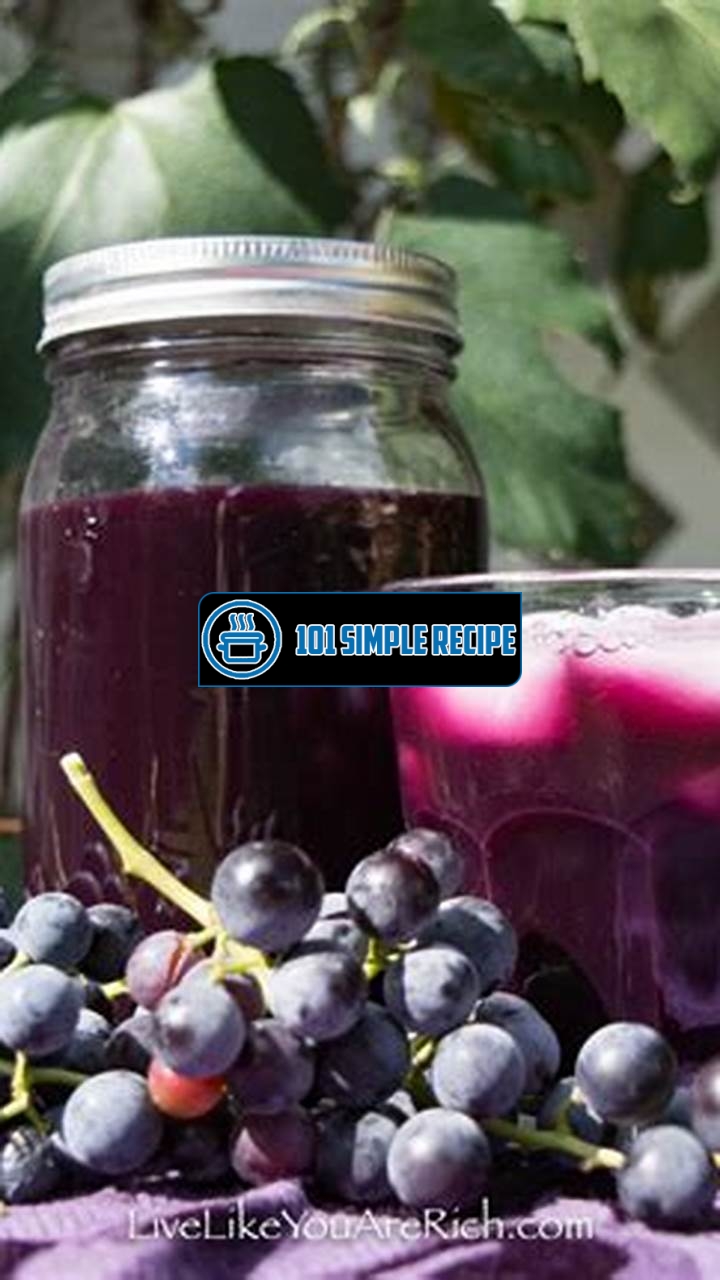Are you tired of store-bought grape juice that is filled with artificial flavors and preservatives? Look no further! With this easy recipe, you can create refreshing homemade grape juice that is healthy, delicious, and completely natural. ✨ Making your own grape juice not only allows you to control the ingredients, but it also gives you the chance to enjoy the pure flavor of grapes bursting with sweetness and tanginess. In just a few simple steps, you’ll have a refreshing beverage to quench your thirst and delight your taste buds. So grab a bunch of fresh grapes, put on your apron, and let’s get started on this homemade grape juice adventure!

The Health Benefits of Grape Juice
Discover the numerous advantages of consuming grape juice for your overall well-being.
Antioxidant Properties of Grape Juice
Grape juice is not only a delicious and refreshing beverage, but it also offers a wide range of health benefits. One of the key advantages of grape juice is its high content of antioxidants. Antioxidants are compounds that help protect our cells from damage caused by harmful molecules called free radicals. These free radicals can lead to various health issues, including chronic diseases and premature aging. By consuming grape juice regularly, you can provide your body with a powerful dose of antioxidants, helping to neutralize free radicals and promote overall health.
Research has shown that grape juice contains several types of antioxidants, including resveratrol, flavonoids, and anthocyanins. These antioxidants have been observed to have anti-inflammatory, anti-cancer, and anti-aging effects.
Additionally, the antioxidant properties of grape juice can help protect against oxidative stress, which is a significant factor in the development of chronic conditions such as heart disease, diabetes, and certain types of cancer. By incorporating grape juice into your diet, you can strengthen your body’s defense mechanisms and reduce the risk of these diseases.
Immune-Boosting Effects of Grape Juice
Grape juice is also known for its immune-boosting effects. Packed with essential vitamins and minerals, including vitamin C, vitamin A, and potassium, grape juice can help fortify your immune system and keep you healthy.
Vitamin C, in particular, is crucial for immune function as it helps stimulate the production of white blood cells that protect the body against infections and illnesses.
Moreover, grape juice contains natural sugars that can provide a quick energy boost, supplying your body with the necessary fuel to fight off pathogens and recover from illnesses faster. It can be an excellent choice to replenish your energy levels when feeling fatigued or weak.
Grape Juice and Heart Health
Heart disease is a prevalent health issue worldwide, and it’s vital to take measures to maintain a healthy cardiovascular system. Including grape juice in your diet can contribute to heart health in several ways.
✨ First, grape juice is rich in polyphenols, which have been associated with a reduced risk of heart disease. Polyphenols help improve blood flow, reduce inflammation, and prevent the formation of blood clots.
Moreover, the high levels of antioxidants in grape juice can provide protection against the oxidation of low-density lipoprotein (LDL) cholesterol, commonly known as “bad” cholesterol. When LDL cholesterol oxidizes, it can lead to the buildup of plaque in the arteries, increasing the risk of heart attacks and strokes. By consuming grape juice, you can reduce the oxidation of LDL cholesterol and promote better heart health.
Additionally, grape juice contains a compound called resveratrol, which has shown potential in lowering blood pressure and improving overall cardiovascular function. Studies have demonstrated that resveratrol may help dilate blood vessels and enhance blood flow, thus reducing the strain on the heart.
In conclusion, incorporating grape juice into your daily routine can bring forth numerous health benefits. From its antioxidant properties to its immune-boosting effects and contributions to heart health, grape juice is a delicious and nutritious beverage that can enhance your overall well-being. Cheers to a refreshing and healthy glass of grape juice!
Selecting the Right Grapes for Juice Making
When it comes to making refreshing homemade grape juice, choosing the right grapes is crucial. The flavor and quality of your juice will greatly depend on the grapes you use. To ensure you end up with a delicious and flavorful juice, follow these tips for selecting the best grapes for juice making.
Varieties of Grapes Suitable for Juice Making
Not all grapes are created equal when it comes to making juice. Some varieties are more suitable due to their flavor profile and juice yield. Here are a few grape varieties that are known to produce excellent juice:
- Concord grapes: Known for their intense flavor and deep purple color, Concord grapes are a popular choice for making grape juice. They have a perfect balance of sweetness and tartness, resulting in a well-rounded flavor.
- Red Flame grapes: These grapes are known for their rich, sweet flavor and vibrant red color. They make a delicious juice that is both refreshing and satisfying.
- Thompson seedless grapes: If you prefer a milder and sweeter flavor, Thompson seedless grapes are a great option. They are light green in color and have a delicate taste that is perfect for making a subtle grape juice.
No matter which variety you choose, make sure the grapes are fresh and of high quality. Avoid grapes that are overripe or have any signs of decay.
Indicators of Ripeness in Grapes
To ensure you select grapes at their peak ripeness for juicing, look out for the following indicators:
- Color: Depending on the variety, ripe grapes can range from deep purple to green or yellow. Choose grapes that are vibrant in color and evenly colored.
- Firmness: Gently squeeze a few grapes to check for firmness. Ripe grapes should feel plump but not too soft or mushy.
- Texture: The skin of ripe grapes should be smooth and taut, without any wrinkles or shriveling.
- Aroma: Give the grapes a sniff. Ripe grapes should have a sweet and fragrant aroma.
By paying attention to these indicators, you can ensure you select grapes that will result in a flavorful and aromatic homemade grape juice.
Organic and Conventional Options
When it comes to choosing grapes for juice making, you have the option to go for organic or conventional grapes. Here are some points to consider:
Organic grapes: Organic grapes are grown without the use of synthetic pesticides, herbicides, or fertilizers. They are a great choice if you prefer to consume fruits that have been grown using natural and sustainable methods.
Conventional grapes: Conventional grapes, on the other hand, are grown using conventional farming methods that may involve the use of synthetic chemicals. While they may be more readily available and less expensive, it’s important to wash them thoroughly to remove any pesticide residue before making grape juice.
Ultimately, the choice between organic and conventional grapes is a personal one. Consider your preferences and values when making your selection.
By following these guidelines and selecting the right grapes, you can ensure that your homemade grape juice turns out delicious and bursting with natural flavors. Cheers to a refreshing and satisfying glass of grape juice!
Preparing the Grapes for Juicing
Before you can enjoy a delicious glass of homemade grape juice, it’s important to properly prepare your grapes. By following these necessary steps, you’ll ensure that your juice turns out refreshing and full of flavor.
Washing and Stemming the Grapes
The first step in preparing your grapes for juicing is to wash them thoroughly. Fill a large bowl with cold water and gently place your grapes into it. Swirl them around to remove any dirt or debris. Rinse them off and transfer them to a colander to drain.
Once your grapes are clean, it’s time to remove the stems. Hold a grape cluster by the stem and use your other hand to pull the grapes off, one by one. Discard the stems and place the stemmed grapes into a separate bowl.
Crushing or Mashing the Grapes
Now that your grapes are clean and stemmed, it’s time to crush or mash them. There are a few different methods you can use depending on the tools you have available.
If you have a grape crusher, simply place a handful of grapes into the crusher and turn the handle to crush them. The juice will flow out through the bottom while the grape skins, seeds, and pulp are left behind.
If you don’t have a grape crusher, you can use a potato masher, a blender, or even your hands. Place a handful of stemmed grapes into a large bowl and use your chosen tool to crush or mash them until they release their juice.
Considering Sugar and Acid Adjustments
Once you have crushed or mashed your grapes, it’s time to consider making any necessary sugar and acid adjustments to achieve the perfect balance of sweetness and tartness in your grape juice.
For a sweeter juice, you can add sugar to taste. Start with a small amount and gradually increase until the desired level of sweetness is achieved. Remember to stir well after each addition to ensure the sugar is fully dissolved.
If your grapes are too tart, you can add a small amount of lemon juice to enhance the flavor. Start with a teaspoon and taste the juice. Continue adding lemon juice in small increments until the desired level of tartness is reached.
It’s important to note that these adjustments should be made based on personal preference. Feel free to experiment and find the balance that suits your taste buds.
By following these steps and properly preparing your grapes, you’ll be well on your way to enjoying a refreshing glass of homemade grape juice. Cheers to your juicing success!
Methods for Extracting Grape Juice
In order to make refreshing homemade grape juice, you need to extract the juice from the grapes first. There are different techniques and equipment that you can use for this process. Let’s explore these methods in detail:
Using a Juicer for Grape Juice Extraction
One of the easiest and most efficient ways to extract grape juice is by using a juicer. A juicer is a kitchen appliance specifically designed to extract juice from fruits and vegetables. When using a juicer for grape juice extraction, follow these steps:
- Preparing the grapes: Wash the grapes thoroughly under running water.
- Feeding the grapes into the juicer: Remove any stems and leaves from the grapes and feed them into the juicer’s chute.
- Collecting the juice: Place a container under the juicer’s spout to collect the extracted grape juice.
- Straining the juice: If desired, strain the juice through a fine-mesh strainer to remove any pulp or seeds.
Note: Juicers come in different types and models, so it’s important to refer to the manufacturer’s instructions for specific usage guidelines.
The Manual Pressing Method
The manual pressing method is a traditional way of extracting grape juice. This method requires simple equipment and can be done by hand. Here are the steps to extract grape juice using the manual pressing method:
- Preparing the grapes: Wash the grapes thoroughly and remove any stems and leaves.
- Macerating the grapes: Place the grapes in a clean container and use a masher or your hands to gently crush them. This will release the juice from the grapes.
- Pressing the grapes: Transfer the crushed grapes to a press, such as a cheese cloth or a fine-mesh bag. Squeeze and twist the press to extract the juice from the grapes. The juice will flow out while the solids remain in the press.
- Collecting the juice: Place a container under the press to collect the extracted grape juice.
- Straining the juice: If desired, strain the juice through a fine-mesh strainer to remove any remaining solids.
The Steam Juicing Technique
The steam juicing technique is a method that uses steam to extract grape juice. This technique is ideal for extracting juice from a large quantity of grapes. Here’s how to use the steam juicing technique:
- Preparing the grapes: Wash the grapes thoroughly and remove any stems and leaves.
- Setting up the steam juicer: Fill the steam juicer’s bottom chamber with water and place the grapes in the top chamber.
- Heating the steam juicer: Heat the steam juicer on the stove and let the steam pass through the grapes. The steam will extract the juice from the grapes.
- Collecting the juice: Place a container under the steam juicer’s spout to collect the extracted grape juice.
- Straining the juice: If desired, strain the juice through a fine-mesh strainer to remove any impurities.
By exploring these different methods for extracting grape juice, you can easily make your own refreshing homemade grape juice using the technique that suits you best. Whether you use a juicer, the manual pressing method, or the steam juicing technique, the end result will be a delicious and healthy beverage.
Storing and Preserving Grape Juice
When it comes to making your own grape juice, ensuring its long-lasting freshness and taste is essential. Proper storage and preservation techniques can help you achieve this goal. Whether you prefer bottling and sealing, freezing, or using citric acid as a preservative, each method has its advantages. Read on to discover effective strategies for storing your homemade grape juice.
Proper Bottling and Seal Techniques
One of the most common ways to store grape juice is by bottling and sealing it. This method helps maintain freshness and extends the shelf life of the juice. To ensure success, follow these steps:
- Clean and sterilize the bottles: Start by washing the bottles thoroughly with warm water and soap. Rinse them well and sanitize them by using boiling water or a commercial sterilizer. This step helps eliminate any bacteria or contaminants that may negatively impact the juice.
- Fill the bottles carefully: Once the bottles are clean and sterilized, pour the grape juice into each bottle, leaving some space at the top. This extra space allows the juice to expand while freezing or bottling.
- Seal the bottles tightly: It is crucial to seal the bottles properly to prevent any air or contaminants from getting in. Use clean and airtight lids or caps to ensure a tight seal. This step helps preserve the flavor and freshness of the grape juice.
By following these bottling and seal techniques, you can enjoy fresh and delicious grape juice for an extended period.
Freezing Grape Juice
Freezing grape juice is another effective method for preserving its freshness, especially if you have a surplus that you want to enjoy later. Here’s how you can freeze your grape juice:
- Prepare the containers: Choose freezer-safe containers or ice cube trays to hold the juice. Make sure they are clean and free from any lingering odors. If using ice cube trays, it will be easier to thaw small portions.
- Pour in the grape juice: Fill each container or ice cube tray with the grape juice, leaving some space at the top for expansion during freezing. Avoid overfilling to prevent any spills or leaks.
- Seal and freeze: Secure the containers or cover the ice cube trays with plastic wrap or lids. Place them in the freezer and allow them to freeze completely. It is recommended to use the juice within six months for optimal taste and quality.
Freezing grape juice not only preserves its taste but also allows you to enjoy it conveniently in smaller portions whenever you desire.
Using Citric Acid as a Preservative
Adding citric acid to your homemade grape juice can help extend its shelf life by inhibiting bacterial growth and maintaining the flavor. Here are the steps to follow:
- Prepare the citric acid solution: Dissolve the appropriate amount of citric acid in water, following the recommended ratio. Make sure it mixes well before using.
- Add the citric acid solution to the juice: Once the grape juice is ready, pour the prepared citric acid solution into it. Stir gently to ensure the acid is evenly distributed throughout the juice.
- Store the juice properly: After adding citric acid, transfer the juice to clean and sterilized containers. Seal them tightly and store them in a cool and dark place. The citric acid will help preserve the juice and maintain its freshness.
Using citric acid as a preservative not only extends the shelf life of your grape juice but also enhances its flavor and tanginess.
Note: Regardless of the storage method you choose, always label your grape juice containers with the date of preparation. This way, you can keep track of its freshness and consume it before it starts to deteriorate.
By following these effective strategies for storing and preserving grape juice, you can enjoy the refreshing taste of your homemade creation for an extended period. Whether you opt for bottling and sealing, freezing, or using citric acid as a preservative, each method offers its unique benefits. Experiment and find the technique that best suits your preferences and taste buds. Cheers to homemade grape juice!
Frequently Asked Questions
Thank you for reading our article on making grape juice! To help you further, we’ve compiled a list of frequently asked questions below:
| No. | Questions | Answers |
|---|---|---|
| 1. | Can I use any type of grapes to make grape juice? | Yes, you can use any type of grapes to make grape juice. Some popular options include Concord, red or green seedless grapes, or Muscadine grapes. Feel free to experiment with different grape varieties to find your preferred flavor. |
| 2. | Do I need a juicer to make grape juice? | No, you don’t necessarily need a juicer to make grape juice. You can use a blender or a food processor to puree the grapes and strain the juice using a fine-mesh sieve or cheesecloth. However, a juicer can make the process easier and more efficient. |
| 3. | Can I add sweeteners to the grape juice? | Yes, you can add sweeteners to the grape juice if desired. Some options include honey, sugar, or even natural sweeteners like stevia. Adjust the sweetness according to your taste preferences. |
| 4. | How long does homemade grape juice last? | Homemade grape juice can last up to one week when refrigerated in a sealed container. It’s best to consume it within a few days to preserve its freshness and taste. |
| 5. | Can I freeze grape juice? | Yes, you can freeze grape juice. Pour the juice into airtight containers or ice cube trays and store in the freezer for up to six months. Thaw the juice in the refrigerator overnight before consuming. |
| 6. | Can I use frozen grapes to make grape juice? | Yes, you can use frozen grapes to make grape juice. Simply thaw the grapes before blending or juicing them. Frozen grapes can add a refreshing twist to your homemade juice. |
Thank You for Reading!
We hope you found our grape juice recipe article helpful and inspiring. Making your own grape juice allows you to control the ingredients and enjoy the pure, natural flavors of grapes. Whether you prefer it chilled on a hot summer day or as a base for delicious cocktails, homemade grape juice is a delightful treat. Don’t forget to bookmark our page for future recipes and tips. Cheers to your grape juice-making adventures!
Jump to Recipe
Making Grape Juice Recipe

Learn how to make grape juice at home with this simple recipe. Enjoy the refreshing taste of homemade grape juice without any additives or preservatives.
- 3 pounds grapes (stemmed)
- 1/4 cup water
- 1-2 tablespoons sweetener (optional)
- Rinse the grapes thoroughly under cool water to remove any dirt or impurities. Remove the stems and discard any damaged or overripe grapes.
- Place the grapes in a blender or food processor. Add the water and blend until smooth.
- Set a fine-mesh sieve or cheesecloth over a large bowl or pitcher. Pour the blended grape mixture into the sieve or cheesecloth and let the juice strain through. Use a spatula or spoon to press down on the solids to extract as much juice as possible.
- Taste the grape juice and add sweetener, if desired. Stir well to combine.
- Pour the fresh grape juice into glasses filled with ice and enjoy immediately. You can also refrigerate the juice in an airtight container for later use.






